Question
The group G has a unique element, h , of order 2.
(i) Show that \(gh{g^{ – 1}}\) has order 2 for all \(g \in G\).
(ii) Deduce that gh = hg for all \(g \in G\).
▶️Answer/Explanation
Markscheme
(i) consider \({(gh{g^{ – 1}})^2}\) M1
\( = gh{g^{ – 1}}gh{g^{ – 1}} = g{h^2}{g^{ – 1}} = g{g^{ – 1}} = e\) A1
\(gh{g^{ – 1}}\) cannot be order 1 (= e) since h is order 2 R1
so \(gh{g^{ – 1}}\) has order 2 AG
(ii) but h is the unique element of order 2 R1
hence \(gh{g^{ – 1}} = h \Rightarrow gh = hg\) A1AG
[5 marks]
Question
A group with the binary operation of multiplication modulo 15 is shown in the following Cayley table.
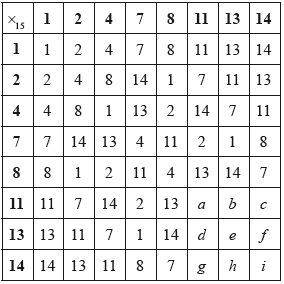
a.Find the values represented by each of the letters in the table.[3]
b.Find the order of each of the elements of the group.[3]
c.Write down the three sets that form subgroups of order 2.[2]
d.Find the three sets that form subgroups of order 4.[4]
▶️Answer/Explanation
Markscheme
\(a = 1\;\;\;b = 8\;\;\;c = 4\)
\(d = 8\;\;\;e = 4\;\;\;f = 2\)
\(g = 4\;\;\;h = 2\;\;\;i = 1\) A3
Note: Award A3 for 9 correct answers, A2 for 6 or more, and A1 for 3 or more.
[3 marks]
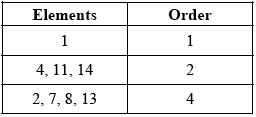 A3
A3
Note: Award A3 for 8 correct answers, A2 for 6 or more, and A1 for 4 or more.
[3 marks]
\(\{ 1,{\text{ }}4\} ,{\text{ }}\{ 1,{\text{ }}11\} ,{\text{ }}\{ 1,{\text{ }}14\} \) A1A1
Note: Award A1 for 1 correct answer and A2 for all 3 (and no extras).
[2 marks]
\(\{ 1,{\text{ }}2,{\text{ }}4,{\text{ }}8\} ,{\text{ }}\{ 1,{\text{ }}4,{\text{ }}7,{\text{ }}13\} ,\) A1A1
\(\{ 1,{\text{ }}4,{\text{ }}11,{\text{ }}14\} \) A2
[4 marks]
Total [12 marks]
Examiners report
The first two parts of this question were generally well done. It was surprising to see how many difficulties there were with parts (c) and (d) with many answers given as {4}, {11} and {14} for example.
The first two parts of this question were generally well done. It was surprising to see how many difficulties there were with parts (c) and (d) with many answers given as {4}, {11} and {14} for example.
The first two parts of this question were generally well done. It was surprising to see how many difficulties there were with parts (c) and (d) with many answers given as {4}, {11} and {14} for example.
The first two parts of this question were generally well done. It was surprising to see how many difficulties there were with parts (c) and (d) with many answers given as {4}, {11} and {14} for example.
Question
The set of all permutations of the elements \(1,{\text{ }}2,{\text{ }} \ldots 10\) is denoted by \(H\) and the binary operation \( \circ \) represents the composition of permutations.
The permutation \(p = (1{\text{ }}2{\text{ }}3{\text{ }}4{\text{ }}5{\text{ }}6)(7{\text{ }}8{\text{ }}9{\text{ }}10)\) generates the subgroup \(\{ G,{\text{ }} \circ \} \) of the group \(\{ H,{\text{ }} \circ \} \).
a.Find the order of \(\{ G,{\text{ }} \circ \} \).[2]
b.State the identity element in \(\{ G,{\text{ }} \circ \} \).[1]
c.Find
(i) \(p \circ p\);
(ii) the inverse of \(p \circ p\).[4]
d.(i) Find the maximum possible order of an element in \(\{ H,{\text{ }} \circ \} \).
(ii) Give an example of an element with this order.[3]
▶️Answer/Explanation
Markscheme
the order of \((G,{\text{ }} \circ )\) is \({\text{lcm}}(6,{\text{ }}4)\) (M1)
\( = 12\) A1
[2 marks]
\(\left( 1 \right){\rm{ }}\left( 2 \right){\rm{ }}\left( 3 \right){\rm{ }}\left( 4 \right){\rm{ }}\left( 5 \right){\rm{ }}\left( 6 \right){\rm{ }}\left( 7 \right){\rm{ }}\left( 8 \right){\rm{ }}\left( 9 \right){\rm{ }}\left( {10} \right)\) A1
Note: Accept ( ) or a word description.
[1 mark]
(i) \(p \circ p = (1{\text{ }}3{\text{ }}5)(2{\text{ }}4{\text{ }}6)(7{\text{ }}9)(810)\) (M1)A1
(ii) its inverse \( = (1{\text{ }}5{\text{ }}3)(2{\text{ }}6{\text{ }}4)(7{\text{ }}9)(810)\) A1A1
Note: Award A1 for cycles of 2, A1 for cycles of 3.
[4 marks]
(i) considering LCM of length of cycles with length \(2\), \(3\) and \(5\) (M1)
\(30\) A1
(ii) eg\(\;\;\;(1{\text{ }}2)(3{\text{ }}4{\text{ }}5)(6{\text{ }}7{\text{ }}8{\text{ }}9{\text{ }}10)\) A1
Note: allow FT as long as the length of cycles adds to \(10\) and their LCM is consistent with answer to part (i).
Note: Accept alternative notation for each part
[3 marks]
Total [10 marks]
Examiners report
[N/A]
[N/A]
[N/A]
[N/A]
Question
The binary operation \( * \) is defined on the set \(T = \{ 0,{\text{ }}2,{\text{ }}3,{\text{ }}4,{\text{ }}5,{\text{ }}6\} \) by \(a * b = (a + b – ab)(\bmod 7),{\text{ }}a,{\text{ }}b \in T\).
a.Copy and complete the following Cayley table for \(\{ T,{\text{ }} * \} \).[4]
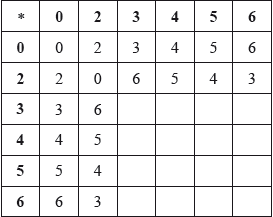
b.Prove that \(\{ T,{\text{ }} * \} \) forms an Abelian group.[7]
c.Find the order of each element in \(T\).[4]
d.Given that \(\{ H,{\text{ }} * \} \) is the subgroup of \(\{ T,{\text{ }} * \} \) of order \(2\), partition \(T\) into the left cosets with respect to \(H\).[3]
▶️Answer/Explanation
Markscheme
Cayley table is
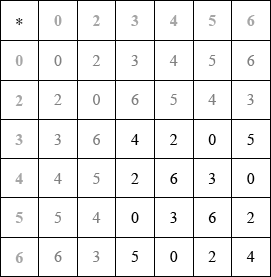 A4
A4
award A4 for all 16 correct, A3 for up to 2 errors, A2 for up to 4 errors, A1 for up to 6 errors
[4 marks]
closed as no other element appears in the Cayley table A1
symmetrical about the leading diagonal so commutative R1
hence it is Abelian
\(0\) is the identity
as \(x * 0( = 0 * x) = x + 0 – 0 = x\) A1
\(0\) and \(2\) are self inverse, \(3\) and \(5\) is an inverse pair, \(4\) and \(6\) is an inverse pair A1
Note: Accept “Every row and every column has a \(0\) so each element has an inverse”.
\((a * b) * c = (a + b – ab) * c = a + b – ab + c – (a + b – ab)c\) M1
\( = a + b + c – ab – ac – bc + abc\) A1
\(a * (b * c) = a * (b + c – bc) = a + b + c – bc – a(b + c – bc)\) A1
\( = a + b + c – ab – ac – bc + abc\)
so \((a * b) * c = a * (b * c)\) and \( * \) is associative
Note: Inclusion of mod 7 may be included at any stage.
[7 marks]
\(0\) has order \(1\) and \(2\) has order \(2\) A1
\({3^2} = 4,{\text{ }}{3^3} = 2,{\text{ }}{3^4} = 6,{\text{ }}{3^5} = 5,{\text{ }}{3^6} = 0\) so \(3\) has order \(6\) A1
\({4^2} = 6,{\text{ }}{4^3} = 0\) so \(4\) has order \(3\) A1
\(5\) has order \(6\) and \(6\) has order \(3\) A1
[4 marks]
\(H = \{ 0,{\text{ }}2\} \) A1
\(0 * \{ 0,{\text{ }}2\} = \{ 0,{\text{ }}2\} ,{\text{ }}2 * \{ 0,{\text{ }}2\} = \{ 2,{\text{ }}0\} ,{\text{ }}3 * \{ 0,{\text{ }}2\} = \{ 3,{\text{ }}6\} ,{\text{ }}4 * \{ 0,{\text{ }}2\} = \{ 4,{\text{ }}5\} ,\)
\(5 * \{ 0,{\text{ }}2\} = \{ 5,{\text{ }}4\} ,{\text{ }}6 * \{ 0,{\text{ }}2\} = \{ 6,{\text{ }}3\} \) M1
Note: Award the M1 if sufficient examples are used to find at least two of the cosets.
so the left cosets are \(\{ 0,{\text{ }}2\} ,{\text{ }}\{ 3,{\text{ }}6\} ,{\text{ }}\{ 4,{\text{ }}5\} \) A1
[3 marks]
Total [18 marks]
Examiners report
[N/A]
[N/A]
[N/A]
Question
The following Cayley table for the binary operation multiplication modulo 9, denoted by \( * \), is defined on the set \(S = \{ 1,{\text{ }}2,{\text{ }}4,{\text{ }}5,{\text{ }}7,{\text{ }}8\} \).
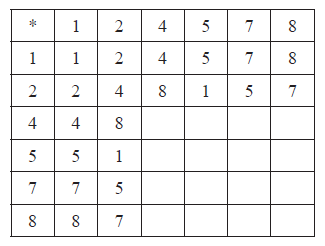
a.Copy and complete the table.[3]
b.Show that \(\{ S,{\text{ }} * \} \) is an Abelian group.[5]
c.Determine the orders of all the elements of \(\{ S,{\text{ }} * \} \).[3]
d.(i) Find the two proper subgroups of \(\{ S,{\text{ }} * \} \).
(ii) Find the coset of each of these subgroups with respect to the element 5.[4]
e.Solve the equation \(2 * x * 4 * x * 4 = 2\).[4]
▶️Answer/Explanation
Markscheme
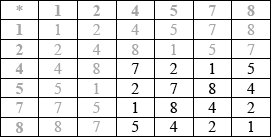 A3
A3
Note: Award A3 for correct table, A2 for one or two errors, A1 for three or four errors and A0 otherwise.
[3 marks]
the table contains only elements of \(S\), showing closure R1
the identity is 1 A1
every element has an inverse since 1 appears in every row and column, or a complete list of elements and their correct inverses A1
multiplication of numbers is associative A1
the four axioms are satisfied therefore \(\{ S,{\text{ }} * \} \) is a group
the group is Abelian because the table is symmetric (about the leading diagonal) A1
[5 marks]
 A3
A3
Note: Award A3 for all correct values, A2 for 5 correct, A1 for 4 correct and A0 otherwise.
[3 marks]
(i) the subgroups are \(\{ 1,{\text{ }}8\} \); \(\{ 1,{\text{ }}4,{\text{ }}7\} \) A1A1
(ii) the cosets are \(\{ 4,{\text{ }}5\} \); \(\{ 2,{\text{ }}5,{\text{ }}8\} \) A1A1
[4 marks]
METHOD 1
use of algebraic manipulations M1
and at least one result from the table, used correctly A1
\(x = 2\) A1
\(x = 7\) A1
METHOD 2
testing at least one value in the equation M1
obtain \(x = 2\) A1
obtain \(x = 7\) A1
explicit rejection of all other values A1
[4 marks]
Examiners report
The majority of candidates were able to complete the Cayley table correctly.
Generally well done. However, it is not good enough for a candidate to say something along the lines of ‘the operation is closed or that inverses exist by looking at the Cayley table’. A few candidates thought they only had to prove commutativity.
Often well done. A few candidates stated extra, and therefore incorrect subgroups.
[N/A]
The majority found only one solution, usually the obvious \(x = 2\), but sometimes only the less obvious \(x = 7\).
Question
An Abelian group, \(\{ G,{\text{ }} * \} \), has 12 different elements which are of the form \({a^i} * {b^j}\) where \(i \in \{ 1,{\text{ }}2,{\text{ }}3,{\text{ }}4\} \) and \(j \in \{ 1,{\text{ }}2,{\text{ }}3\} \). The elements \(a\) and \(b\) satisfy \({a^4} = e\) and \({b^3} = e\) where \(e\) is the identity.
Let \(\{ H,{\text{ }} * \} \) be the proper subgroup of \(\{ G,{\text{ }} * \} \) having the maximum possible order.
a.State the possible orders of an element of \(\{ G,{\text{ }} * \} \) and for each order give an example of an element of that order.[8]
b.(i) State a generator for \(\{ H,{\text{ }} * \} \).
(ii) Write down the elements of \(\{ H,{\text{ }} * \} \).
(iii) Write down the elements of the coset of \(H\) containing \(a\).[7]
▶️Answer/Explanation
Markscheme
orders are 1 2 3 4 6 12 A2
Note: A1 for four or five correct orders.
Note: For the rest of this question condone absence of xxx and accept equivalent expressions.
\(\begin{array}{*{20}{l}} {{\text{order:}}}&1&{{\text{element:}}}&2&{A1} \\ {}&2&{}&{{a^2}}&{A1} \\ {}&3&{}&{b{\text{ or }}{{\text{b}}^2}}&{A1} \\ {}&4&{}&{a{\text{ or }}{a^3}}&{A1} \\ {}&6&{}&{{a^2} * b{\text{ or }}{a^2} * {b^2}}&{A1} \\ {}&{12}&{}&{a * b{\text{ or }}a * {b^2}{\text{ or }}{a^3} * b{\text{ or }}{a^3} * {b^2}}&{A1} \end{array}\)
[8 marks]
(i) \(H\) has order 6 (R1)
generator is \({a^2} * b\) or \({a^2} * {b^2}\) A1
(ii) \(H = \left\{ {e,{\text{ }}{a^2} * b,{\text{ }}{b^2},{\text{ }}{a^2},{\text{ }}b,{\text{ }}{a^2} * {b^2}} \right\}\) A3
Note: A2 for 4 or 5 correct. A1 for 2 or 3 correct.
(iii) required coset is \(Ha\) (or \(aH\)) (R1)
\(Ha = \left\{ {a,{\text{ }}{a^3} * b,{\text{ }}a * {b^2},{\text{ }}{a^3},{\text{ }}a * b,{\text{ }}{a^3} * {b^2}} \right\}\) A1
[7 marks]
Question
The binary operation multiplication modulo 10, denoted by ×10, is defined on the set T = {2 , 4 , 6 , 8} and represented in the following Cayley table.
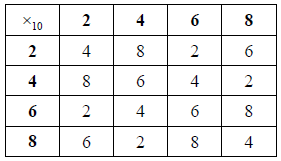
a.Show that {T, ×10} is a group. (You may assume associativity.)[4]
b.By making reference to the Cayley table, explain why T is Abelian.[1]
c.i.Find the order of each element of {T, ×10}.[3]
c.ii.Hence show that {T, ×10} is cyclic and write down all its generators.[3]
d.The binary operation multiplication modulo 10, denoted by ×10 , is defined on the set V = {1, 3 ,5 ,7 ,9}.
Show that {V, ×10} is not a group.[2]
▶️Answer/Explanation
Markscheme
closure: there are no new elements in the table A1
identity: 6 is the identity element A1
inverse: every element has an inverse because there is a 6 in every row and column (2−1 = 8, 4−1 = 4, 6−1 = 6, 8−1 = 2) A1
we are given that (modulo) multiplication is associative R1
so {T, ×10} is a group AG
[4 marks]
the Cayley table is symmetric (about the main diagonal) R1
so T is Abelian AG
[1 mark]
considering powers of elements (M1)
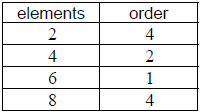 A2
A2
Note: Award A2 for all correct and A1 for one error.
[3 marks]
EITHER
{T, ×10} is cyclic because there is an element of order 4 R1
Note: Accept “there are elements of order 4”.
OR
{T, ×10} is cyclic because there is generator R1
Note: Accept “because there are generators”.
THEN
2 and 8 are generators A1A1
[3 marks]
EITHER
considering singular elements (M1)
5 has no inverse (5 ×10 a = 1, a∈V has no solution) R1
OR
considering Cayley table for {V, ×10}
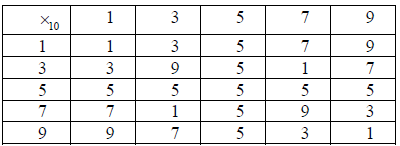 M1
M1
the Cayley table is not a Latin square (or equivalent) R1
OR
considering cancellation law
eg, 5 ×10 9 = 5 ×10 1 = 5 M1
if {V, ×10} is a group the cancellation law gives 9 = 1 R1
OR
considering order of subgroups
eg, {1, 9} is a subgroup M1
it is not possible to have a subgroup of order 2 for a group of order 5 (Lagrange’s theorem) R1
THEN
so {V, ×10} is not a group AG
[2 marks]
Examiners report
[N/A]
[N/A]
[N/A]
[N/A]
[N/A]
